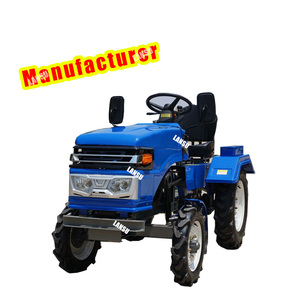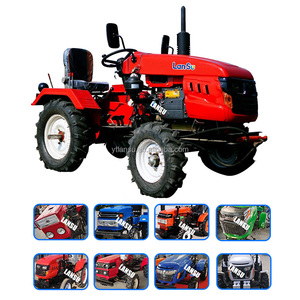
All categories
Featured selections
Trade Assurance
Buyer Central
Help Center
Get the app
Become a supplier

(7939 products available)



























The 4 row corn planter, which is often called ''4 row corn seeder'' or ''4 row corn planting machine'', has different styles. Here are some commonly used kinds.
Tractor-mounted planters
Horse-drawn planters are large machines. They are fixed to the back of tractors by three points. They use the power of tractors to plant corn seeds. These planters are meant for tractors with lower planting capacity. With planter frames and seed barrels, they can effectively plant corn seeds on large tracts of land.
Pull-behind planters
The pull-behind planter has a hitch attached to it. This hitch connects it to vehicles like trucks or tractors. It drags the planter by itself after it is hitched to the vehicle. The corn seed is dispensed by gravity into the furrow formed by the dragging of the planter. The depth of planting is determined by the height of the drag chain or shovels.
Pull-behind planters with hoppers
The hoppers in the pull-behind planters store different types of corn seeds. It is usually big, and the hitch can be rigid or adjustable depending on the kind of crops to be planted.
Air planters
An air pressure system is used to blow corn seeds from a big hopper into the soil's surface. The seed can be dispersed uniformly over a wide area with a little effort by using this method.
Box planters
It is one of the most popular types of 4 row corn planter for sale. The planters normally come with a box, which is also called a hopper, that holds the seeds. Usually, they are referred to as ''planters with gear boxes'' or ''drill planters with hoppers'' and fall into the category of pull-behind planters.
The following specifications are typical for a planter like the one described above.
Size
A four-row corn planter typically has an overall length of 8 to 12 feet and a width of 8 to 10 feet. The height ranges between 6 and 8 feet. The planter fits well behind a typical farm tractor or truck.
Weight
A four-row corn planter weighs between 1,500 and 3,000 pounds, depending on whether it is built from light aluminum or heavy-duty steel. Heavier planters provide extra stability, while lighter ones are more fuel efficient.
Capacity
Four-row corn planters have varying capacities. One common capacity is 45 bushels for corn or 30 bushels for soybeans. The planter will have separate compartments and discharge systems for each of these crops.
Packing wheels
The packing wheels at the back of the planter help to cover the seeds and exert enough pressure on the soil to enhance seed germination. Packing wheels typically have a diameter of 12 to 16 inches. The width varies depending on the design and purpose, with some planters having packing wheels that cover the entire row area.
Hitch
A four-row corn planter has either a drawbar or three-point hitch. The planter has a discrete center point near the rear, which makes it easy to tow. Using a drawbar provides a simple, cost-effective way of linking the planter to a towing vehicle.
Proper maintenance ensures efficient seed planting and long service life.
Cleaning
Cleaning after each use removes dirt, dust, and residue from the planting process. Use a pressure washer or compressed air to blow out debris from hard-to-reach areas. Cleaning keeps the seed delivery system, including seed cups and hoses, free from clogs.
Lubrication
Lubricate all moving parts of the planter, including chains, bearings, and grease fittings, to prevent excessive wear and tear. Choose a high-quality lubricant for long-lasting protection. Regular lubrication minimizes friction and extends component life.
Inspection
Carry out an inspection of the planter after every use. Check for loose or damaged components, including belts, blades, and bearings. Re-tighten any loose parts and replace damaged components immediately. This frequent inspection helps to keep the planter operating optimally with minimal downtime.
4 row corn planters are useful for large-scale commercial corn farming. They are efficient, saving time while planting multiple rows of corn. Farmers can use these planters to plant other crops in wide spacings as well.
Farmers usually prepare the soil before planting day by tilling it. The 4-row corn planter will be used in fields with tilled soil ready for corn seeds to be dropped in at the correct depth and spaced appropriately. Corn seeds will be dropped in fields with other crops when using planters for crop rotation. Corn Planters will also be used in these scenarios to plant crops in wide spacings where tilling is not possible, such as between established plants like beans.
In situations where the 4 row corn planter has no tractor or power source, hand planting is an option. Hand planting is the least preferred method because of the labor it requires, but it is an option in some cases when power sources are limited. Using a power unit or tractor attached to a 4-row corn planter improves the amount planted per hour compared to smaller planters.
Buying an appropriate corn planter can be a challenging experience for business buyers. Considering diverse planting requirements and budget constraints, here's a detailed guide to help select the most suitable four-row corn planters for specific needs.
soil type and field conditions
Smarter business buyers must examine the soil type and field conditions before purchasing a corn planter. Understanding these two factors enables them to choose planters with appropriate row units and seedbed preparations. For example, equipped with disc openers, row units work well in soils requiring precise seed placement, such as sticky or heavy loams. An option with fluted walk-seed aggregators may suffice for sandy or lighter loam fields. Also, planters with adequate frame widths and clearances for tackling uneven terrain are selected.
planter features
Consider several important features each planter has. From seed types and sizes to precision planting and pneumatic downforce systems, the selected planter should have suitable features for corn planting demands. Choosing a suitable planter fosters improved yield results.
planter sizes and row configurations
Business buyers who operate large corn-planted fields see the importance of choosing a proper planter size for each acreage. In most cases, wide-planter configurations are preferable. However, narrow-width, high-number row configurations suits some specific field conditions. For instance, the available four-row corn planters with 30-inch rows are ideal for fields with great obstacle clearing requirements, while four-row planters with 36-inch rows may work better in some marginal areas.
age and technology of planter
When considering the 4 row corn planter for sale in the market, business buyers prioritize planters that maximize efficiency and productivity while reducing planting costs. Emphasis is placed on the planter's age, as older models lack advanced features when compared to newer models.
durability and build quality
A durable and well-built corn planter cuts down costs incurred from frequent repairs and replacements. Pay attention to the durability and build quality of the planter offered by the supplier. Also, planters manufactured by popular brand names tend to be more durable and retain better resale value.
Q1: Who should operate a 4 corn planter?
A1: The four-row corn planter is designed to be handled by a few people, ideally one or two. It is suitable for small-scale planting of corn and other crops. However, before the planting process can go smoothly, the person in charge should have the necessary skills and knowledge to operate the planter effectively.
Q2: How long does it take to plant with a 4 row corn planter?
A2: Several factors affect the amount of time, including the efficiency of the planter, the speed at which it is operated, the planting density of the crop being planted, and the terrain and conditions of the land. On average, planters can plant corn at a rate of roughly 4 to 6 acres per hour using a four-row corn planter.
Q3: Does a corn planter plant other crops?
A3: Yes, corn planters can be used to plant other crops as well. They are typically used to plant crops that are grown in rows, such as soybeans, cotton, sunflowers, peanuts, sorghum, barley, oats, and certain vegetable crops. However, if planter specifications indicate it is only suitable for corn, then it is best to use it solely for corn.
Q4: What is the best way to transport a corn planter?
A4: Detach the planter from any hitch or towing mechanism before transporting it. While transporting, secure it carefully so that it does not get damaged during the way, and at the same time, ensure that it is safe for the driver. This is because when transporting agricultural machinery like corn planters, damage to the machinery or accidents can happen in an instant if the driver is not careful.
Q5: Can the seed depth be adjusted on a corn planter?
A5: Yes, the seed depth on a corn planter can be adjusted. Most planters have depth control mechanisms that allow the operator to set the desired planting depth. Proper seed depth is crucial for corn emergence and development, so it is essential to adjust the planter to achieve the recommended planting depth for the specific soil and environmental conditions.